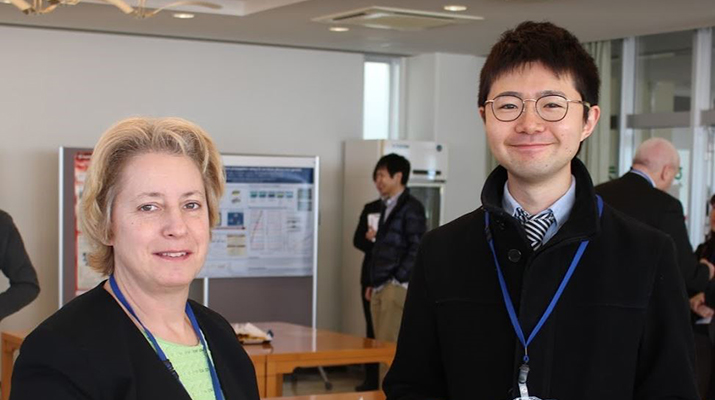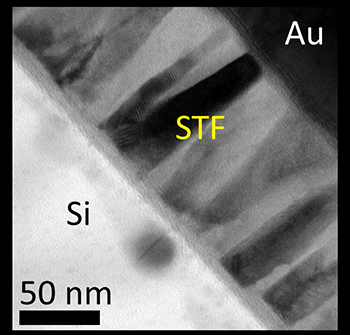
ここからコンテンツです。

Nano-polycrystalline film leads to stronger magnetism compared to single-crystal films
Oxygen defects like nanopillars enhanced magnetic and magnetooptical response of STF films By Taichi Goto
Taichi Goto and his colleagues have found that nanoscale pillar-shaped distribution of iron in strontium titanate changes its magnetic and magnetooptical response drastically. This research was achieved in cooperation with researchers at Myongji University, Harbin Institute of Technology, Massachusetts Institute of Technology, Universidad Técnica Federico Santa María, University of California, San Diego, and Trinity College Dublin. Surprisingly, the polycrystalline film on the silicon substrate showed stronger magnetism than a single crystalline film.
To realize the next generation of devices for information processing based on new phenomena such as spintronics, multiferroics, magnetooptics, and magnonics, their constituent materials need to be developed. Recent rapid progress in nanotechnology allows us to fabricate nanostructures that are impossible to obtain in nature.
However, complex magnetic oxides are one of the most complicated material systems in terms of development and analysis. In addition, the detailed mechanism, by which changes in atomic composition that do not affect overall structure lead to drastic changes in material characteristics even though the material structure is similar, is as yet unknown.
Now, researchers from Toyohashi University of Technology’s Spin Electronics Group, as part of a research team (which includes Myongji University, Harbin Institute of Technology, Massachusetts Institute of Technology, Universidad Técnica Federico Santa María, University of California San Diego, and Trinity College Dublin), have found that nanoscale pillar-shaped distribution of iron in strontium titanate (STF) changes its magnetic and magnetooptical response drastically. Surprisingly, the polycrystalline sample showed stronger magnetism than single crystalline film.
"In usual oxide systems, magnetic and magnetooptical effects are stronger in highly ordered structures. In other words, single crystalline material is better for obtaining better magnetic properties,” explains Assistant Professor Taichi Goto, “However, iron-substituted strontium titanate deposited at certain oxygen pressure is different."

The STF films were prepared by pulsed laser deposition at various pressures directly on silicon substrate, and crystalline structure and magnetic properties were characterized systematically. A sample deposited at a certain pressure showed significantly stronger magnetism and larger Faraday rotation angle (magnetooptical effects) at room temperature. Several tests analyzing the oxygen stoichiometry and the corresponding Fe valence states, the structure and strain state, and the presence of small-volume fractions of iron revealed that the nanostructure and clustering of the elements enhanced magnetism.
These results show the broad possibility of polycrystalline films being used in silicon-based devices. In this paper, the integration of STF film with 0.1 mm scale optical resonator was demonstrated. Further, the integration of such novel oxides with conventional device concepts could pave a way for interesting systems in the future.
Funding agency:
- T. G. acknowledges support from the JST PRESTO, JSPS Postdoctoral Fellowships for Research Abroad, Grant-in-Aid for Young Scientists (A) No. 26706009, and Challenging Exploratory Research No. 26600043.
- C. R. acknowledges support from the NSF DMR1419807 and ECCS1607865 and from FAME, a SRC STARnet Center supported by DARPA and MARCO.
- H. L. T. acknowledges support from the NSF DMR1419807. P. V. acknowledges support from the Center for Development of Nanoscience and Nanotechnology, CEDENNA, Chile.
- J. M. F. acknowledges support from Fondecyt Iniciación 11130128 and DGIIP USM, Chile.
- M.I. acknowledges support from the JSPS Grant-in-Aid for Scientific Research (S) No. 26220902.
This work utilized the shared experimental facilities of the Center for Materials Science and Engineering (CMSE), Award 024006-10 No. NSF DMR1419807.
Reference
Taichi Goto, Dong Hun Kim, Xueyin Sun, Mehmet C. Onbasli, Juan M. Florez, Shyue Ping Ong, Patricio Vargas, Karl Ackland, Plamen Stamenov, Nicolas M. Aimon, Mitsuteru Inoue, Harry L. Tuller, Gerald F. Dionne, J. Michael D. Coey and Caroline A. Ross, "Magnetism and Faraday rotation in oxygen-deficient polycrystalline and single-crystal iron-substituted strontium titanate", Phys. Rev. Applied, 7, 024006 (2017/02/08).
https://doi.org/10.1103/PhysRevApplied.7.024006
単結晶が高性能という常識を覆すSi上の多結晶磁性膜を発見
多結晶の鉄置換チタン酸ストロンチウムが示す磁性後藤太一助教らは、ミョンジ大学、ハルビン工業大学、MIT、フェデリコ・サンタ・マリア工科大学、カリフォルニア大学サンディエゴ校、およびトリニティ・カレッジダブリン大学と共同で、ナノサイズの鉄が柱状に集まった鉄置換チタン酸ストロンチウム膜が単結晶を超える大きな磁性および磁気光学特性を示すことを世界で初めて見出し、この膜を使ったシリコン光デバイスの作製に成功しました。
近年の半導体中を流れる電子を利用した電子デバイスの高集積化に伴い、発熱や高速化の鈍化が喫緊の課題です。そこで、現在の電子デバイスのデザインルールを根本から変えてしまう、異なった物理に基づいた次世代コンピュータの開発が求められています。そんな中、電子の移動以外を起源とする現象に注目が集まっています。スピントロニクス、マグノニクス、あるいは磁性を介するマルチフェロイクスは、スピンを起源とすることから、電子デバイスの抱える発熱やスピードの課題を解決できると期待されております。これに伴い、これらのスピンを使ったデバイスの基盤となる材料開発の重要性は、年々高まっています。最近では、人工的にナノスケールの構造を操作することで、自然界に存在し得ない超高性能な材料開発が進められています。
しかし、数ある材料のなかでも、複合磁性酸化物は、その構造が最も複雑な材料系の一つであり、似たような構造をもつ材料システムであっても元素の数が僅かに異なると特性が極端に変わるなど、分かっていない部分が多くあります。
今回、豊橋技術科学大学のスピン・エレクトロニクスグループはミョンジ大学、ハルビン工業大学、MIT、フェデリコ・サンタ・マリア工科大学、カリフォルニア大学サンディエゴ校、およびトリニティ・カレッジダブリン大学と共同で、ナノサイズの鉄が柱状に集まった鉄置換チタン酸ストロンチウム(STF)膜が、単結晶を超える大きな磁性および磁気光学特性を示すことを世界で初めて見出し、この膜を使ったシリコン光デバイスの作製に成功しました。
「ほとんどの磁性酸化物システムで、原子や分子が緻密に並んだ単結晶の方が、並び方がバラバラな多結晶に比べて、磁性および磁気光学効果は大きいとされてきました。言い換えれば、単結晶のほうが多結晶よりも性能がよいのが、ある意味普通でした。」と後藤助教は話す。「しかし、ある一定の圧力下で形成したSTFでは、多結晶の方が磁気光学効果が大きくなったのです。」
幾つかの成膜圧力下で、シリコン基板上にバッファー層なしで直接STF膜を形成し、結晶構造や磁気特性をシステマティックに調べました。この中で、一定の圧力下で形成した試料だけ、室温環境下で、著しく大きな磁気および磁気光学効果を示すことが分かりました。磁性が増大された要因を調べたところ、クラスター上に鉄の成分が柱のように凝集したことにあると、明らかになりました。
これらの結果は、基板を問わない多結晶膜の磁気および磁気光学膜としての応用可能性を広げます。すでに筆者らは本論文の中で、開発した多結晶STF膜をシリコン導波路で作ったリング型の光干渉器と融合することで、0.1mmサイズの光アイソレータを形成し、動作をデモンストレーションしたことを報告しています。今後は、開発したSTFと光集積デバイス以外との組合せや、異なる材料システムでの類似現象の発現などが期待されます。
ファンディングエージェンシー:
JST さきがけ
JSPS 科研費 No. 26706009、26600043、26220902
Researcher Profile

| Name | Taichi Goto |
|---|---|
| Affiliation | Department of Electrical and Electronic Information Engineering |
| Title | Assistant Professor |
| Fields of Research | Magnetics / Optics/ Photonics/ Nanotechnology |
ここでコンテンツ終わりです。
